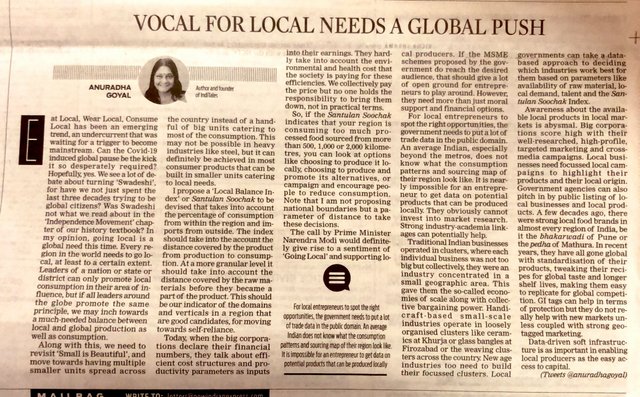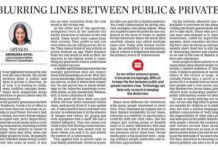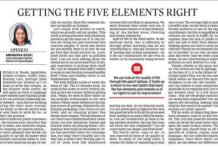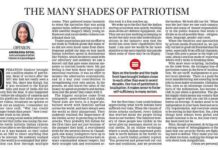This article Vocal for Local by Anuradha Goyal, author, and founder of IndiTales.com was first published by the New Indian Express newspaper on June 11, 2020.
Eat Local, Wear Local, Consume Local has been an emerging trend, in short Vocal for Local is an undercurrent that was waiting for a trigger to become mainstream. Can the Covid-19 induced global ‘Pause’ be the kick it so desperately required? Hopefully, Yes. We see a lot of debate about turning ‘Swadeshi’, for have we not just spent the last three decades trying to be global citizens. Was Swadeshi not what we read about in the ‘Independence Movement’ chapter of history textbook? In my opinion, this time going local is a global need. Every region in the world needs to go local, at least to a certain extent.
Leaders of a nation or state or district can only promote local consumption in their area of influence, but if all leaders around the globe promote the same principle, we may inch towards a much-needed balance between local and global production as well as consumption.
Vocal for Local
Along with this we need to re-visit the ‘Small is Beautiful’, and move towards having multiple smaller units spread across geography instead of a handful of big units catering to majority consumption. It may not be possible in heavy industries like steel, but it can definitely be achieved in most consumer products that can be built in smaller units catering to local needs.
Balance Index for the Vocal for Local
I propose a ‘Local Balance Index’ or ‘Santulan Soochak’ to be devised that takes into account the percentage of consumption from within the region and imports from outside. An index should take into account the distance covered by the product from production to consumption. At a more granular level, it should take into account the distance covered by the raw materials before they became a part of the product. This should be our indicator of the domains and verticals in a region that are good candidates for moving towards self-reliance.
Today when the big corporations declare their financial numbers, they talk about efficient cost structures and productivity parameters as inputs into their earnings. They hardly take into account the environmental and health cost that the society is paying for those efficiencies. We collectively pay for the price but no one holds the responsibility to bring them down, not in practical terms.
Read More – Innovative Ideas to Explore
Distance
So, if the ‘Santulan Soochak’ indicates that your region is consuming too much of the processed food sourced from more than 500, 1000, or 2000 KMs of distance. You can look at options like – Choosing to produce it locally. Choosing to produce and promote alternatives. Or at the very least campaign and encourage people to reduce consumption. Note that I am not proposing national boundaries but a parameter of distance to make these decisions.
The call by the prime minister Modi would definitely give rise to a sentiment of ‘Going Local’ and supporting local producers. If the MSME schemes proposed by the government do reach the desired audience, that should give a lot of open ground for the entrepreneurs to play around. However, they need more than just moral support and finance options.
Opportunities for Local Entrepreneurs
To spot the right opportunities for local entrepreneurs, governments need to provide a lot of trade data in the public domain. An average Indian, especially beyond the metros, does not know what are the consumption patterns and sourcing map of their region look like. It is nearly impossible for an entrepreneur to get data on potential products that can be produced locally. They obviously cannot invest in market research. Strong Industry-Academia research linkages can potentially help.
Clusters
Traditional Indian businesses operated in clusters. Where each individual business was not too big but collectively, they are an industry, concentrated in a small geographic area. This gave them the so-called economies of scale and collective bargaining power. Handicraft based small scale industries operate in loosely organized clusters. Like ceramics at Khurja or glass bangles at Firozabad or the weaving clusters across the country. New age industries too need to build their focussed clusters. Local governments can take a data intelligence-based approach to decide which industries work best for them. Based on parameters like availability of raw material, local demand, talent, and Samtulan Soochak Index.
Awareness to succeed in Vocal for Local
Awareness about the available local products in local markets is abysmal. Big corporations score high with their well-researched, high profile, targeted marketing, and cross-media campaigns. Local businesses do need focussed local campaigns to highlight their products and their local origin. Government agencies can also pitch in by public listing of local businesses and local products. A few years ago, there were strong local food brands in almost every region of India. Be it the Bhakarwadi of Pune or Pedha of Mathura. In the last 2-3 decades, they have all gone global with standardization of their products. Tweaking their recipes for global taste and longer shelf lives. Making them easy to replicate for global competition. GI tags can help in terms of protection. But they do not really help with new markets. Unless coupled with stronger geo-tagged marketing.
Data-driven soft infrastructure is as important in enabling local producers as easy access to capital.

Edited for this online publication.








